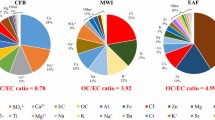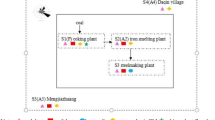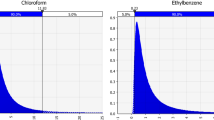Abstract
In Taiwan 24-h coffee shops have become popular gathering areas for young people. This study assesses customers' exposures to PM2.5 and gaseous/particulate polycyclic aromatic hydrocarbons (PAHs) in such an environment. Potential influential factors were also evaluated. Two coffee shops with different types of smoking/nonsmoking divisions were selected. Sampling was conducted from 1300 to 2100 hours on Saturdays and Sundays during December 2000 and January 2001. Personal environmental monitors mounted with Teflon filters and polyurethane foams were used for particulate and gaseous sampling. PAHs were analyzed with GC-FID. Principal component analysis was used to explore the differences in the patterns of gaseous and particulate PAHs. Stepwise regression analysis was used to evaluate the contribution of various factors. The geometric mean (GM) of PM2.5, particulate and gaseous PAH exposures were 83.7, 0.46 and 1.01 μg/m3, respectively. Their exposure concentrations were about two to five times those of residential indoor environments in Taiwan. Smoking and vehicle exhaust were two major exposure sources. The gaseous PAH concentrations in the two sections of both shops were significantly correlated. The divisions between smoking and nonsmoking sections in neither of the coffee shops were effective to prevent dispersion of gaseous pollutants. In both shops, the concentrations of PM2.5 and associated PAHs, respectively, were about 22–28 μg/m3 and 0.07 μg/m3 higher in smoking areas compared to nonsmoking areas. It was also found that each additional cigarette resulted in a 0.22–0.42 μg/m3 PM2.5 incremental increase in nonsmoking customers' exposure in the smoking section.
This is a preview of subscription content, access via your institution
Access options
Subscribe to this journal
Receive 6 print issues and online access
$259.00 per year
only $43.17 per issue
Buy this article
- Purchase on Springer Link
- Instant access to full article PDF
Prices may be subject to local taxes which are calculated during checkout



Similar content being viewed by others
References
Chuang J.C., Mack G.A., Kihlman M.R., and Wilson N.K. Polycyclic aromatic hydrocarbons and their derivatives in indoor and outdoor air in an eight-home study. Atmos Environ 1991: 25B: 369–380.
Crimmer G., Naujack K.-W., and Dettbarn G. Gaschromatographic determination of Polycyclic aromatic hydrocarbons, aza-arenes, aromatic amines in the particle and vapor phase of mainstream and sidestream smoke of cigarettes. Toxicol Lett 1987: 35: 117–124.
Department of Health, Republic of China, Health Statistics. Department of Health, Executive Yuan, Republic of China, 2000.
Gundel L.A., Mahanama K.R.R., and Daisey J.M. Semivolatile and particulate polycyclic aromatic hydrocarbons in environmental tobacco smoke: cleanup, speciation, and emission factors. Environ Sci Technol 1995: 29: 1607–1614.
Kleinbaum D.G., Kupper L.L., and Muller K.E. Applied Regression Analysis and Other Multivariable Methods. PWS-KENT Publishing Company, Boston, 1987.
Li C.S., and Ro Y.S. Indoor characteristics of polycyclic aromatic hydrocarbons in the urban atmosphere of Taipei. Atmos Environ 2000: 34: 611–620.
Lim L.H., Harrison R.M., and Harrad H. The contribution of traffic to atmospheric concentrations of polycyclic aromatic hydrocarbons. Environ Sci Technol 1999: 33: 3538–3542.
Liu X., Gao N., Hopke P.K., Cohen D., Bailey G., and Crisp P. Evaluation of spatial patterns of fine particle sulfur and lead concentrations in New South Wales, Australia. Atmos Environ 1996: 30: 9–24.
Lung S.-C.C., Kao M.C., and Hu S.C. Contribution of incense burning to indoor PM10 and particle-bound polycyclic aromatic hydrocarbons under two ventilation conditions. Indoor Air 2003: 13: 194–199.
Marr L.C., Kirchstetter T.W., Harley R.A., Miguel A.H., Hering S.V., and Hammond S.K. Characterization of polycyclic aromatic hydrocarbons in motor vehicle fuels and exhaust emissions. Environ Sci Technol 1999: 33: 3091–3099.
Offerman F.J., Loiselle S.A., Hodgson A.T., Gundel L.A., and Daisey J.M. A pilot study to measure indoor concentrations and emission rates of polycyclic aromatic hydrocarbons. Indoor Air 1991: 4: 497–512.
Ozeki T., Kiode K., and Kimoto T. Evaluation of sources of acidity in rainwater using a constrained oblique rotational factor analysis. Environ Sci Technol 1995: 29: 1638–1645.
Plog B.A., Niland J., and Quinlan P.J. Fundamentals of Industrial Hygiene. National Safety Council, Itasca, IL, 1996: pp. 602–606.
Shiau H.C. Characteristics of indoor particulate polycyclic aromatic hydrocarbons. M.S. Thesis National Taiwan University in Taipei, Taiwan, June, 1997.
Shine J.P., Ika R.V., and Ford T.E. Multivariate statistical examination of spatial and temporal patterns of heavy metal contamination in New Bedford Harbor marine sediments. Environ Sci Technol 1995: 29: 1781–1788.
United States Environmental Protection Agency. Integrated Risk Information System. United States Environmental Protection Agency, Washington DC, last revised March 31, 1987.
United States Environmental Protection Agency. Method 610 Methods for Organic Chemical Analysis of Municipal and Industrial Wastewater, EPA-600/4-82-057, Environmental Monitoring and Support Laboratory, Cincinnati, OH, July, 1982.
UNSCEAR (United Nations Scientific Committee on the Effects of Atomic Radiation). Sources, Effects and Risks of Ionizing Radiation, Report to the General Assembly, Publication E. 88.IX. 7, United Nations, New York, 1993.
Author information
Authors and Affiliations
Corresponding author
Rights and permissions
About this article
Cite this article
Lung, SC., Wu, MJ. & Lin, CC. Customers' exposure to PM2.5 and polycyclic aromatic hydrocarbons in smoking/nonsmoking sections of 24-h coffee shops in Taiwan. J Expo Sci Environ Epidemiol 14, 529–535 (2004). https://doi.org/10.1038/sj.jea.7500371
Received:
Accepted:
Published:
Issue Date:
DOI: https://doi.org/10.1038/sj.jea.7500371
Keywords
This article is cited by
-
Measurement of fine particles and smoking activity in a statewide survey of 36 California Indian casinos
Journal of Exposure Science & Environmental Epidemiology (2011)
-
Exposure to environmental tobacco smoke in German restaurants, pubs and discotheques
Journal of Exposure Science & Environmental Epidemiology (2008)
-
Analysis of polycyclic aromatic hydrocarbons (PAHs) in environmental samples: a critical review of gas chromatographic (GC) methods
Analytical and Bioanalytical Chemistry (2006)



